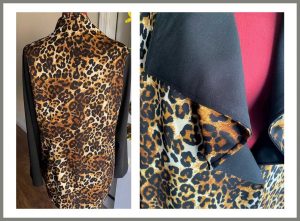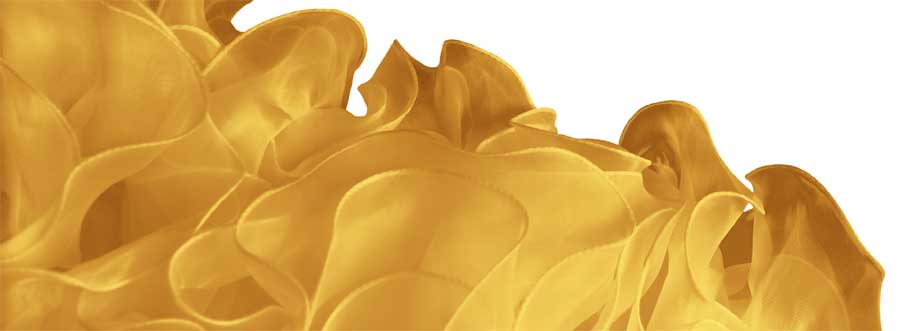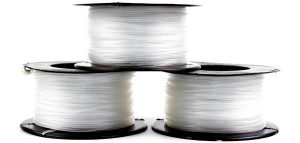Sheryl Belson from the Plano chapter of ASG recently held a fireside chat with Jenny Rushmore from Cashmerette. The Cashmerette pattern line offers modern, elegant designs for curvy sewists, as well as classes and online workshops including fitting for curves, swimsuit making for curves, full bust adjustments and more. Focusing exclusively on plus-sizes, her patterns celebrate curves, confidence and limitless style. ASG members can enjoy a 20% discount on everything in the Cashmerette line, including patterns and classes, for one week only, May 13-19, 2020, with the discount code available in the Members Only Special Offers section.
What I’m Sewing: Pamela’s Patterns Jacket #121
For nearly a year, we have been featuring articles on independent pattern designers and their companies. Now it’s your turn to tell us who you are sewing and share your experiences. In this first article, Princeton Chapter President, Joen Venitsky, tells us about her experience making a jacket from Pamela Leggett’s collection of Pamela’s Patterns. She used a knit animal print which is so popular this year.
If you are an ASG member and have a favorite pattern from an independent designer, we would love to hear from you. Go to the Members Only area and complete the What I’m Sewing pattern review form. We are looking forward to seeing your creations and hearing of your experiences!
What I’m Sewing

I have attended a number of classes with Pamela Leggett and have loved every one of them. When her new Cascade Cardi or Blazer pattern came out, I knew I just had to try it. I was not disappointed.
Q. Item Created
A. Jacket
Q. Independent Pattern Designer
A. Pamela’s Patterns
Q. Name and Number of Pattern
A. #121 Cascade Cardi or Blazer
Q. Fabric Used
A. Ponte Knit
Q. Special Embellishments/Notions Used
A. Gold Button and Interfacing
Q. Skill level required?
A. Intermediate to Advanced Beginner
Q. Are the instructions easy to follow?
A. Yes, Pamela’s Patterns have great fitting and pattern adjustment tips to help you get the perfect fit. The pattern includes a full bust pattern piece, which I used and was happy I didn’t have to do a full bust adjustment. You Tube video references are also included throughout the instructions for certain pattern details.
Q. Are you pleased with the finished result? Did it meet your expectations?
A. Yes, I was very pleased with the results and how the jacket looked.
Q. Did it look like the picture?
A. I believe it did with the exception of the contrasting sleeve and collar detail.
Q. Did you make any modifications in the pattern?
A. No, thankfully the full bust pattern piece was included with the pattern.
Q. Are there any changes you would have made?
A. I would like to try the tapered sleeve on my next blazer for summer when I would wear a cami or tank underneath.
Q. Did the pattern teach you any unique or special techniques?
A. Wrapped corner technique, which I did not know was taught by Nancy Zieman, and as Pamela states is life changing!
Q. Would you make this again?
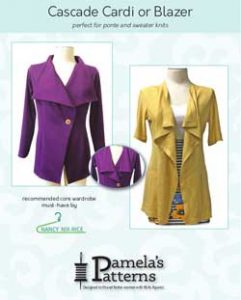 A. Absolutely! It’s a great way to add to my wardrobe.
A. Absolutely! It’s a great way to add to my wardrobe.
Q. Would you recommend this pattern to others?
A. Yes, if you are looking for a comfortable knit jacket or cardi to add to your wardrobe, this pattern is for you!
This pattern may be purchased at PamelasPatterns.com. Don’t forget that Pamela offers ASG members a discount which can be found on the Special Offers page. Not a members? Join today!
~Joen Venitsky, Princeton ASG Chapter President
Uncommon Threads: Fusible, Invisible & Water-Soluble
Into every sewer’s life, a little novelty must fall, and such is the case with threads—those ones you don’t use every day, but when you need them, they serve a specific purpose.
Fusible Thread
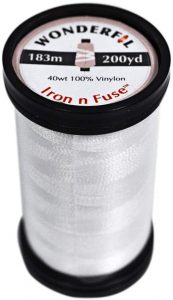
Fusible thread, as its name suggests, is heat sensitive and melts when needed. Much like its notion cousin, fusible web, the thread can provide a thin and targeted line of adhesive. But, where would you use that?
Fusible thread is ideal for matching plaid and stripes at a seamline, as it can hold the design pattern in place while you sew the seam—just align adjacent pieces, fuse and sew. It’s also ideal to keep zippers from moving while stitching a centered application and for holding trims in position. Making a narrow hem? Use it in the bobbin (or serger lower looper) and fuse the hem in place. Need a crisp edge on a pleat or pants crease? Place a strand inside the fold line and fuse. Use it in the bobbin for understitching a facing—then press to help keep it in place.
Fusible thread can be used in the bobbin, in the serger loopers or through a large-eye needle. Test-stitch first to check tension. Use it on the side of the fabric where fusing will be needed for the final application.
A niche product akin to fusible thread is Secura by Coats (members, don’t forget to use your Nancy’s Notions discount!). It’s not a traditional fusible thread, but made specifically for sewing on buttons. When you’re done stitching the button on, touch the thread with the tip of the iron and it fuses to itself for a secure hold.
Invisible Thread
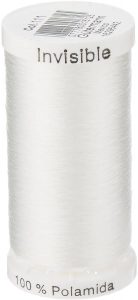
Made from either nylon or polyester, this no-see-um monofilament thread is available in clear and smoke. Usable in the needle and/or bobbin, it’s ideal for appliquéing, sewing on trims, quilting and couching, as the stitches virtually disappear. It’s ideal for allover quilting where stitching crosses multiple colors in a single print, and for stitching in the ditch on garments or trim applications.
If your machine has issues feeding invisible thread, use a thread net or a thread stand for more consistent feeding.
Note that nylon can be stiffer and melts at a lower temperature than its polyester counterpart. It can also discolor and become brittle with age.
Water-soluble Thread
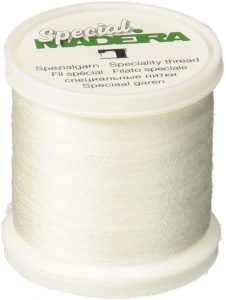
A favorite of quilters, water-soluble thread can be used in the needle, bobbin or lower looper on a serger. It does require a bit of special care—firstly, don’t lick the ends to thread a needle as it will dissolve. Keep it in a sealed bag, especially if you live in a humid climate, and mark it so it doesn’t get mixed up with regular sewing thread.
Water-soluble thread is ideal for basting quilt layers together, then after quilting, it can be removed by washing or simply wetting and brushing, depending on the brand. It can also be used anywhere a temporary hold is needed until more permanent construction can be completed—think basting a garment together for fitting.
~Linda Griepentrog
Linda is the owner of G Wiz Creative Services and she does writing, editing and designing for companies in the sewing, crafting and quilting industries. In addition, she escorts fabric shopping tours to Hong Kong. She lives at the Oregon Coast with her husband Keith, and two dogs, Yohnuh and Abby. Contact her at .
Fishy Flounces: Flounced Hem
Normally, fishing line would be found in the tackle box or with rods and reels in the garage, but why not try bringing a spool of it into your sewing room to create awesome ruffled edges and hems with your serger? The secret is encasing the fishing line in the stitching to create undulating edges with aplomb.
Ruffled edges are ideal for eveningwear, costumes and skirt hems. This technique works best on bias edges and on the crosswise of knit fabrics, but it will also work on lengthwise or crosswise edges to a lesser extent.
What kind of fishing line?
Fishing line comes in a variety of weights, types and colors, but for sewing purposes look for a clear, monofilament line between 12 and 60 weight. The larger the number, the thicker the line. If you’re buying one specifically for sewing ruffles, 25-30 is a happy medium, though you might want a lighter weight for thin fabrics like chiffon.
Although not required, check to see if your serger has a beading or other foot that has a top center guide that the fishing line can slide through.
It’s important to test-stitch before you begin serging on the actual project, as this process can be a bit tricky. If you have trouble with uneven feeding and squirmy fabric, add some water-soluble stabilizer under the fabric and serge through it as a temporary aid to even feeding.
- Set your machine for a rolled hem setting. Each machine differs slightly, so consult your owner’s manual for specifics.
- Leave a 12” tail of fishing line, then begin stitching over only the fishing line. After you’ve serged for about an inch, lift the foot and place the edge of your fabric wrong side up under the line, then continue stitching. It’s helpful to actually serge about ¼” inside the cut fabric edge rather than trying to align the monofilament with the actual fabric edge. Hold the line to guide it along the seamline, but don’t stretch the fabric. The line must rest between the needle and the cutting blade as it’s very important not to cut it.
- Serge slowly encasing the fishing line as you stitch. If you accidentally cut into the line, you’ll need to stop, remove some stitches and begin again with a new portion of line, so make every effort not to nick it and maintain one continuous piece around the entire hemline or ruffle edge.
- When you reach the end of the edge you’re working with, leave another 12” tail of fishing line. Remove the project from the serger and gently stretch the encased fabric edge for maximum ruffling. Thread some of the fishing line tails back into your stitching, or if it’s a soft, flexible line, tie a knot to secure.
Tip: Be careful pressing over the fishing line, as some of it is nylon and will melt easily.
For more information on serger sewing, see the Serger videos in the Members Only area.
~Linda Griepentrog
Linda is the owner of G Wiz Creative Services and she does writing, editing and designing for companies in the sewing, crafting and quilting industries. In addition, she escorts fabric shopping tours to Hong Kong. She lives at the Oregon Coast with her husband Keith, and two dogs, Yohnuh and Abby. Contact her at .
Shelter in Place, Save Money and Sew!
You are living your best quarantine life, sewing up a storm and suddenly realize you are out of… or can’t find… or never had… something you need to finish your project. No matter what it is, you have no interest in going out into COVID world to pick up a spool of thread, a rotary cutter blade or a new pair of thread snips to replace the ones you must have dropped into the trash because they are nowhere to be found.
Now what?
Did you realize just how many of these things you can order online with a member discount?
We combed through the entire list of Special Offers just for members on ASG.org and created this table with the companies who carry some frequently needed sewing notions for you to have at your fingertips. Be sure you visit the members only Special Offers page to get the discount code to use when you place your order. Now it’s your turn! Go replenish your supply from the safety of your own home and enjoy great discounts while you do.

~Sheryl Belson
- « Previous Page
- 1
- …
- 56
- 57
- 58
- 59
- 60
- …
- 79
- Next Page »





